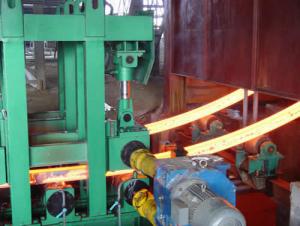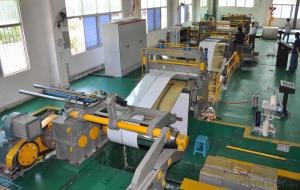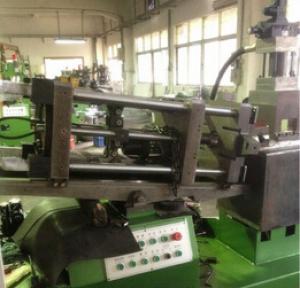Continuous Casting Machine for Steel Billet
- Loading Port:
- China Main Port
- Payment Terms:
- TT or LC
- Min Order Qty:
- 1 Set set
- Supply Capability:
- 30 Sets Per Year set/month
OKorder Service Pledge
Quality Product, Order Online Tracking, Timely Delivery
OKorder Financial Service
Credit Rating, Credit Services, Credit Purchasing
You Might Also Like
Technology process:
1.Heat the EVA film
2.Cover the heated EVA film on the mould(can be made from wood or aluminum)
3.Spray a coating in a certain baume degree
4.Put on the empty blask
5.Sand-up the flask and vibrate to compaction
Packaging & Delivery
Packaging Details:containers
Delivery Detail:Complete one set of equipment needs for three months
- Q: How is the molten metal poured into the mold using metal casting machinery?
- In metal casting machinery, the process of pouring molten metal into the mold is known as casting. This process involves several steps to ensure accuracy and precision in creating the desired metal object. Firstly, the mold is prepared by creating a cavity in the shape of the desired object. The mold can be made from various materials such as sand, ceramic, or metal, depending on the type of metal being cast and the complexity of the object. Once the mold is ready, it is securely placed in the casting machinery. The machinery consists of a crucible, which is a container that holds the molten metal. The crucible is typically made from a material with high melting point and good thermal conductivity, such as graphite or ceramic. The metal is heated in a separate furnace until it reaches its melting point. Once molten, the metal is transferred to the crucible in the casting machinery. This can be done manually or using automated systems, depending on the scale and complexity of the casting process. Once the molten metal is in the crucible, it is ready to be poured into the mold. This is done by tilting or rotating the crucible, allowing the molten metal to flow out and into the mold cavity. The pouring mechanism in the machinery ensures controlled and precise pouring to avoid any spillage or defects in the final product. During the pouring process, it is crucial to maintain the temperature of the molten metal to prevent premature solidification or cooling. This can be achieved by using insulating materials around the mold and employing heating elements if necessary. After the molten metal is poured into the mold, it is left to cool and solidify. The cooling time depends on the type and thickness of the metal being cast. Once solidified, the mold is removed, and the metal object is extracted. Overall, the process of pouring molten metal into the mold using metal casting machinery involves precise control of temperature, pouring mechanism, and mold preparation. This ensures that the final product meets the required specifications and quality standards.
- Q: How does metal casting machinery handle the removal of filters from castings?
- Metal casting machinery typically uses a variety of methods to handle the removal of filters from castings. One common approach is the use of mechanical knock-off devices or vibratory equipment, which apply a controlled force to dislodge and remove the filters. Another method involves the application of compressed air or water jets to blow or wash away the filters. Additionally, some advanced casting machines incorporate automated robotic systems that can precisely remove filters from castings. Overall, the specific technique employed depends on the type of casting machine and the requirements of the casting process.
- Q: What are the different types of casting defects that can occur in shell molding?
- There are several types of casting defects that can occur in shell molding, which is a casting process that involves the use of a shell mold made from a mixture of resin and sand. These defects can vary in severity and can affect the overall quality and integrity of the castings. One common type of casting defect in shell molding is called sand inclusion. This occurs when loose sand particles become trapped in the molten metal and become embedded in the final casting. Sand inclusion can weaken the casting and lead to premature failure. Another defect is called shrinkage. Shrinkage defects occur when the molten metal cools and contracts, causing voids or cavities to form in the casting. These voids can weaken the casting and make it more susceptible to cracking or breaking under stress. Misruns are another type of defect that can occur in shell molding. Misruns happen when the molten metal fails to completely fill the mold cavity, resulting in an incomplete casting. This defect is often caused by insufficient pouring temperature or inadequate gating system design. Cold shuts are defects that occur when two or more streams of molten metal fail to fuse together properly during the filling of the mold cavity. This results in a visible line or seam on the final casting, which can weaken the structure and reduce its overall strength. Surface defects, such as roughness or pitting, can also occur in shell molding. These defects can be caused by a variety of factors, including improper mold preparation, poor surface finish of the pattern, or the presence of contaminants in the molten metal. Lastly, dimensional inaccuracies can occur in shell molding, leading to casting defects. These inaccuracies can include variations in the overall size, shape, or thickness of the casting, which can result from factors such as improper mold assembly, inconsistent pouring temperature, or inadequate cooling and solidification processes. Overall, these are some of the different types of casting defects that can occur in shell molding. It is crucial to identify and address these defects during the manufacturing process to ensure the production of high-quality castings that meet the desired specifications and performance requirements.
- Q: What are the different types of defect repair methods used in metal casting machinery?
- Metal casting machinery utilizes a variety of defect repair methods, each designed to address specific defects that may arise during the casting process. Some commonly employed methods include: 1. Welding: Cracks and porosity in metal castings can be effectively repaired through welding. This involves melting the base metal and introducing filler material to fill the defective area. Welding techniques such as gas metal arc welding, shielded metal arc welding, or tungsten inert gas welding are utilized based on the specific defect requirements. 2. Grinding and polishing: Surface defects like roughness, burrs, or excess material can be eliminated using grinding and polishing techniques. Grinding entails using abrasive wheels or belts to remove surplus material, while polishing involves the use of fine abrasives to achieve a smooth surface finish. This method is particularly effective in addressing cosmetic defects in metal castings. 3. Machining: Machining is commonly employed to rectify defects that occur in critical areas of metal castings, such as dimensional inaccuracies or improper surface finishes. This process involves the removal of excess material using cutting tools like drills, lathes, or milling machines. Machining ensures precise dimensions and desired surface finishes, meeting the required specifications. 4. Heat treatment: Heat treatment is utilized to enhance the mechanical properties of metal castings. By subjecting the casting to controlled heating and cooling processes, desired hardness, strength, or ductility can be achieved. Heat treatment effectively addresses defects such as residual stresses, improper grain structure, or inadequate mechanical properties. 5. Re-melting and re-casting: In severe cases where conventional repair methods are insufficient, the defective casting can be re-melted and re-cast to eliminate defects. This involves melting the defective casting and pouring the molten metal into a new mold, resulting in a flawless casting. It is important to consider the specific nature and severity of the defect, desired outcome, and cost considerations when choosing a defect repair method. Skilled technicians and engineers in metal casting machinery employ these various methods to ensure the production of high-quality castings that meet the required specifications.
- Q: How does metal casting machinery ensure dimensional accuracy and precision?
- Metal casting machinery ensures dimensional accuracy and precision through various mechanisms and controls. These include precise molds, advanced computer-aided design and manufacturing software, automated processes, and rigorous quality control measures. The machinery is designed to create molds with high precision, ensuring that the final product is produced according to the desired dimensions. Computer-aided design and manufacturing software help in accurately designing and simulating the casting process, allowing for adjustments to be made to achieve the desired dimensions before actual production. Automated processes further enhance accuracy by minimizing human error and achieving consistent results. Additionally, thorough quality control measures are implemented throughout the casting process, such as dimensional inspections and testing, to ensure the final product meets the required standards of accuracy and precision. Overall, metal casting machinery combines advanced technologies and meticulous quality control to ensure dimensional accuracy and precision in the production of metal castings.
- Q: How are patterns made for metal casting machinery?
- Patterns for metal casting machinery are typically made using a combination of computer-aided design (CAD) software and traditional machining techniques. The process involves designing the desired shape and dimensions of the pattern using CAD software, which is then converted into a digital file. This file is used to guide the machining equipment, such as CNC mills or lathes, to shape the pattern from a block of material, usually wood or metal. The pattern is then assembled, finished, and coated with a release agent before being used in the metal casting process.
- Q: How is the casting inspected for surface defects in metal casting machinery?
- The casting is inspected for surface defects in metal casting machinery through various methods such as visual inspection, dye penetrant testing, magnetic particle inspection, and ultrasonic testing. These techniques help identify any cracks, porosity, shrinkage, or other surface defects that may affect the quality and integrity of the casting.
- Q: How is the porosity of castings controlled with metal casting machinery?
- The control of porosity in castings can be achieved through various techniques and process parameters using metal casting machinery. The quality and characteristics of the mold used in the casting process are one of the primary factors that affect porosity. It is important for the mold material to have good permeability and venting properties, allowing gases to escape during the solidification of the metal. In addition, the design of the gating system and the placement of risers are crucial in controlling porosity. The gating system helps direct the flow of molten metal into the mold, while the risers act as reservoirs to feed the molten metal as it solidifies. Proper design of the gating system and risers enables a smooth and controlled flow of metal, minimizing turbulence and the entrapment of gases. Controlling the temperature of the mold is another critical factor in preventing porosity. Maintaining the appropriate mold temperature ensures proper solidification and reduces the likelihood of hot spots or cold shuts that can lead to porosity. This can be achieved by using cooling channels or by controlling the temperature of the mold material itself. Furthermore, the selection and control of casting process parameters, such as pouring temperature, pouring speed, and solidification time, are essential in controlling porosity. Monitoring the pouring temperature prevents excessive turbulence and gas entrapment, while controlling the pouring speed ensures a smooth flow of metal. Optimizing the solidification time allows for the escape of gases and complete filling of the mold cavity. Lastly, the use of various additives and alloys can also aid in controlling porosity. Grain refiners, for example, can promote a finer grain structure, reducing the likelihood of porosity. Degassing agents can remove dissolved gases from the molten metal, minimizing the potential for gas porosity. In conclusion, controlling porosity in castings with metal casting machinery involves a combination of factors, including mold quality, gating system design, mold temperature control, casting process parameters, and the use of additives and alloys. By carefully considering and optimizing these factors, manufacturers can achieve castings with minimal porosity and improved quality.
- Q: How do you stay updated on the latest developments and innovations in metal casting technology?
- To stay updated on the latest developments and innovations in metal casting technology, there are several effective strategies that one can employ. First and foremost, it is crucial to actively engage with industry publications and journals that focus on metal casting. Subscribing to these publications and regularly reading articles and research papers can provide valuable insights into the latest advancements in the field. Some well-known publications in the industry include the International Journal of Metalcasting, Metal Casting Design & Purchasing, and Foundry Trade Journal. Attending relevant conferences, trade shows, and exhibitions is another effective way to stay updated on the latest developments in metal casting technology. These events often feature keynote speeches, technical sessions, and exhibitions where industry experts and companies showcase their innovations. In addition to gaining knowledge from presentations and discussions, attending these events also provides an opportunity to network with professionals and learn from their experiences. Joining professional organizations and associations related to metal casting can also be highly beneficial. These organizations often organize workshops, seminars, and webinars that focus on the latest advancements in the field. Engaging with fellow professionals through these platforms allows for knowledge sharing and staying updated on the current trends and developments. Utilizing online resources such as industry-specific websites, blogs, and forums is another effective way to stay updated. Many companies and experts in the field maintain websites or blogs where they regularly share insights, case studies, and news related to metal casting technology. Participating in online forums and discussion boards dedicated to metal casting can also provide a platform for exchanging ideas, discussing advancements, and learning from others in the industry. Lastly, building a network of contacts within the metal casting industry is crucial for staying updated. Regularly attending industry events, engaging in discussions with professionals, and actively participating in online communities can help establish and nurture these connections. By fostering relationships with experts and peers, one can gain access to insider knowledge, industry updates, and the latest innovations in metal casting technology. In summary, staying updated on the latest developments and innovations in metal casting technology requires a proactive approach. Engaging with industry publications, attending conferences and exhibitions, joining professional organizations, utilizing online resources, and building a network of contacts are all effective strategies to ensure one remains informed and up-to-date in this ever-evolving field.
- Q: How does metal casting machinery contribute to waste reduction?
- Metal casting machinery contributes to waste reduction by enabling the efficient use of raw materials. The precision and control offered by these machines reduce material waste during the casting process. Additionally, the ability to recycle and reuse excess metal scraps and casting molds further minimizes waste generation, promoting a more sustainable manufacturing process.
Our professions include metallurgical technology, equipment and automation. We can provide the best solutions to the production process, design & manufacture of equipment and electrical automation regarding various industries in domestic and foreign districts with exquisite technology and fine quality service. We can provide all-around services to customers from development & design to the provision, installation and running of products.Strong technical strength, advanced equipment manufacturing technology, fine quality professional talents, and perfect service systems all bring about reliability, relaxation, convenience and delight to the cooperation with customers from beginning to end.
1. Manufacturer Overview
| Location | Jiangsu,China (Mainland) |
| Year Established | 2000 |
| Annual Output Value | |
| Main Markets | South America Eastern Europe Southeast Asia Africa Mid East South Asia Domestic Market |
| Company Certifications |
2. Manufacturer Certificates
| a) Certification Name | |
| Range | |
| Reference | |
| Validity Period |
3. Manufacturer Capability
| a) Trade Capacity | |
| Nearest Port | SHANGHAI |
| Export Percentage | 21% - 30% |
| No.of Employees in Trade Department | 3-5 People |
| Language Spoken: | English, Chinese |
| b) Factory Information | |
| Factory Size: | |
| No. of Production Lines | |
| Contract Manufacturing | |
| Product Price Range | |
Send your message to us
Continuous Casting Machine for Steel Billet
- Loading Port:
- China Main Port
- Payment Terms:
- TT or LC
- Min Order Qty:
- 1 Set set
- Supply Capability:
- 30 Sets Per Year set/month
OKorder Service Pledge
Quality Product, Order Online Tracking, Timely Delivery
OKorder Financial Service
Credit Rating, Credit Services, Credit Purchasing
Similar products
Hot products
Hot Searches
Related keywords






















